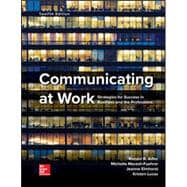Contents
Preface
Part One: Basics of Business and Professional Communication
Strategic Case: Sundown Bakery
1: Communicating at Work
Communication and Career Success
The Nature of Communication
Communication Principles
Basics of the Communication Model
Communication Channels
Communicating in and beyond Organizations
Formal Communication Networks
Informal Communication Networks
Personal Networking
Ethical Dimensions of Communication
Master the Chapter
Review Points
Key Terms
Activities
References
2: Communication, Culture, and Work
The Nature of Culture
Communication in a Diverse Society
Race and Ethnicity
Social Class
Generational Differences
Regional Differences
Disabilities
Sex and Gender
Military Veterans
Cultural Differences in International Business
Customs and Behavior
Fundamental Dimensions of Cultural Diversity
Diversity and Ethical Issues
Communicating across Diversity
Become Culturally Literate
Develop Constructive Attitudes
Adapt Your Behavior
Master the Chapter
Review Points
Key Terms
Activities
References
Part Two: Personal Skills
Strategic Case: Omnicom Marketing
3: Listening
Listening at Work
The Importance of Listening
Assumptions about Listening
Barriers to Effective Listening
Environmental Barriers
Physiological Barriers
Psychological Barrier
Listening Styles
Relational Listening
Analytical Listening
Task-Oriented Listening
Critical Listening
Listening More Effectively
Listening to Understand
Listening to Evaluate
Master the Chapter
Review Points
Key Terms
Activities
References
4: Verbal and Nonverbal Messages
Verbal Messages
Clarity and Ambiguity
Inflammatory Language
Language and Identity Management
Feminine and Masculine Language Use
Nonverbal Communication
Characteristics of Nonverbal Communication
Types of Nonverbal Communication
Improving Nonverbal Effectiveness
Master the Chapter
Review Points
Key Terms
Activities
References
5: Interpersonal Strategies and Skills
Interpersonal Skills and Success
Building Positive Relationships
Affirming Dignity
Enhancing Organizational Climate
Sharing Feedback
Giving Praise
Raising Difficult Issues
Offering and Responding to Criticism
Dealing with Difficult People and Situations
Incivility
Workplace Bullying
Sexual Harassment
Problematic Communication
Managing Conflict
Causes of Conflict
Approaches to Conflict
Handling Conflicts Constructively
Master the Chapter
Review Points
Key Terms
Activities
References
6: Principles of Interviewing
Types of Interviews
The Information-Gathering Interview
The Career Research Interview
The Employment Interview
The Performance Appraisal Interview
Interviewing Strategies
Planning the Interview
Conducting the Interview
The Ethics of Interviewing
Obligations of the Interviewer
Obligations of the Respondent
Master the Chapter
Review Points
Key Terms
Activities
References
Part Three: Working in Groups
Strategic Case: Museum of Springfield
7: Leading and Working in Teams
The Nature of Teams
Characteristics of Work Groups
What Makes a Group a Team?
Virtual Teams
Leadership and Influence in Teams
Perspectives on Leadership
Leader–Member Exchange
Becoming a Leader
Power and Influence of Members
Effective Communication in Teams
Fill Functional Roles
Recognize Both Team and Personal Goals
Promote Desirable Norms
Promote an Optimal Level of Cohesiveness
Avoid Excessive Conformity
Master the Chapter
Review Points
Key Terms
Activities
References
8: Effective Meetings
Types of Meetings
Information-Sharing Meetings
Problem-Solving and Decision-Making Meetings
Ritual Activities
Virtual Meetings
Conference Calls
Web Conferences
Video Conferences
Collaborative Technologies
Planning a Meeting
When to Hold a Meeting
Setting an Agenda
Pre-Meeting Work
Conducting the Meeting
Setting the Tone
Conducting Business
Concluding the Meeting
Following Up the Meeting
Master the Chapter
Review Points
Key Terms
Activities
References
9: Developing and Organizing the Presentation
Analyzing the Situation
Analyzing the Audience
Analyzing Yourself as the Speaker
Analyzing the Occasion
Setting Your Goal and Developing the Thesis
General and Specific Goals
Developing the Thesis
Organizing the Body
Brainstorming Ideas
Basic Organizational Plan
Identify Main Points and Subpoints
Choose the Best Organizational Pattern
Rules for Main Points
Planning the Introduction and Conclusion
Functions of the Introduction
Types of Opening Statements
Functions of the Conclusion
Types of Closing Statements
Adding Transitions
Functions of Transitions
Characteristics of Effective Transitions
Master the Chapter
Review Points
Key Terms
Activities
References
10: Verbal and Visual Support in Presentations
Functions of Supporting Material 000
Clarity 000
Interest 000
Proof 000
Verbal Support 000
Definitions 000
Examples 000
Stories 000
Statistics 000
Comparisons 000
Quotations 000
Citing Your Sources 000
Visual Aids 000
Types of Visual Aids 000
Media for Presenting Visual Aids 000
Presentation Software 000
Guidelines for Using Visual Aids 000
Master the Chapter 000
Review Points 000
Key Terms 000
Activities 000
References 00
11: Delivering the Presentation
Types of Delivery
Manuscript Presentations
Memorized Presentations
Extemporaneous Presentations
Impromptu Presentations
Guidelines for Delivery
Visual Elements
Verbal Elements
Vocal Elements
Question-and-Answer Sessions
When to Answer Questions
How to Manage Questions
Speaking with Confidence
Accept a Moderate Amount of Nervousness
Speak More Often
Rehearse Your Presentation
Focus on Your Topic and the Audience
Think Rationally about Your Presentation
Master the Chapter
Review Points
Key Terms
Activities
References
12: Types of Business Presentations
Informative Presentations
Briefings
Reports
Training
Webinars
Press Conferences
Persuasive Presentations
Types of Persuasive Presentations
Strategies for Ethical Persuasion
Group Presentations
Approaches to Organizing a Group Presentation
Introductions, Conclusions, and Transitions in Group Presentations
Delivering a Group Presentation
Special-Occasion Speaking
Welcoming a Guest or Group
Introducing Another Speaker
Honoring a Person or an Institution
Giving a Toast
Presenting an Award
Accepting an Award
Master the Chapter
Review Points
Key Terms
Activities
References
Appendix I: Interviewing Materials
Appendix II: Business Writing
Appendix III: Problem-Solving Communication
Appendix IV: Sample Presentations
Appendix V: Crisis Communication
Glossary
Index








